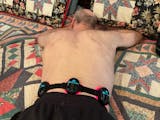Exploring Low-Level Laser Therapy for Knee Osteoarthritis in Elderly Patients: A Promising Alternative
Knee osteoarthritis (OA) is a common problem in older patients, frequently resulting in substantial discomfort and reduced strength that hinders everyday activities. Conventional therapies like autologous platelet-rich plasma (PRP) injections and total knee replacement surgery may not be suitable for these individuals, particularly those on antiplatelet or anticoagulant medications or those with poor physical health. Prolonged use of nonsteroidal anti-inflammatory drugs (NSAIDs) can also result in negative gastrointestinal consequences. Therefore, there is an urgent requirement for alternative interventions to relieve knee OA symptoms in the elderly.
Innovative Approach: Low-Level Laser Therapy (LLLT)
In a recent investigation, a group of 19 elderly individuals who were diagnosed with moderate knee osteoarthritis (OA) and suprapatellar bursitis participated in a study that explored the potential of low-level laser therapy (LLLT) as an alternative treatment option. This novel method involved the utilization of flexible fiber optic wires that were carefully inserted into the knee joint under the guidance of ultrasound imaging. The therapy itself consisted of three sessions of red laser treatment followed by infrared irradiation, which were administered on a bi-weekly basis.
Assessing the Efficacy of LLLT
In order to assess the efficacy of LLLT, scientists quantified the Lequesne index for knee osteoarthritis (OA) and the quantity of suprapatellar synovial fluid (SF). Furthermore, an extensive analysis of SF proteomics was carried out over a duration of six months to evaluate the long-term effects.
Promising Results
The study's findings were compelling:
- Improved Functional Status: After three LLLT sessions, there was a significant decrease in the Lequesne index, indicating enhanced knee joint functionality.
- Reduced Inflammation: The volume of suprapatellar SF and SF proteins associated with inflammation decreased notably, with these improvements persisting for at least three months.
The findings indicate that LLLT has the potential to enhance knee functionality and decrease inflammation, presenting itself as a feasible therapeutic alternative for older individuals who are not suitable candidates for surgery or PRP injections.
Advantages of LLLT
- Non-Invasive: Unlike surgery or injections, LLLT is a minimally invasive procedure, reducing the risk of complications and recovery time.
- Safe for Medicated Patients: Elderly patients on antiplatelet or anticoagulant medications can safely receive LLLT without the associated risks of other treatments.
- Sustained Benefits: The therapeutic effects of LLLT, including pain reduction and improved joint function, were sustained for several months, highlighting its potential for long-term management of knee OA.
Conclusion
With the increasing age of the population, the incidence of knee osteoarthritis is on the rise, emphasizing the necessity for efficient and readily available treatments. This research sheds light on the potential of low-level laser therapy (LLLT) as a viable option for addressing knee OA in older patients, particularly those who are not eligible for more invasive interventions.
To gain further insights into cutting-edge therapies and the most recent studies on the management of osteoarthritis, we invite you to delve into our blog and delve into our comprehensive reservoir of knowledge on knee osteoarthritis. Embracing these breakthroughs has the potential to significantly enhance the overall well-being and medical outcomes for individuals grappling with this enduring ailment.
















Share:
Exploring the Immediate Benefits of Multi-Focal Low-Level Laser Therapy on Quadriceps in Knee Osteoarthritis Patients
Unveiling Relief: The Power of Photobiomodulation Therapy for Chronic Neck Pain